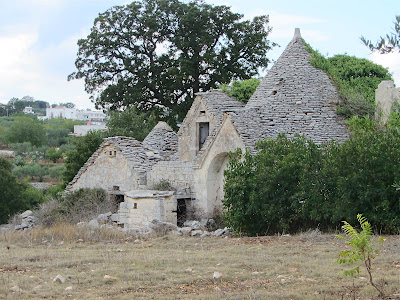9-21-12 FIUMICINO, ITALIA: Yesterday we did Pompei which is fairly close to Sorrento, one more corniche and three tunnels and a little of the Autostrada. The ruins are on the southern flank of Vesuvius which erupted in 79 AD and buried the town under 20 feet of volcanic ash. Previously it had been severely damaged by an earthquake in 62 AD and was still in the midst of rebuilding when it was suffocated. The excavations were begun in the 18 C and continue.
The present site is extensive, covering many acres, and would take days to see it all in detail. We hit the highlights on a hot, sunny afternoon and have many pix. You will be subjected to only a few.
The day we were there, there were probably as many visitors as originally inhabited the city. We used a map and audioguides and felt that was enough. High points include the forum, baths, remnants of frescoes, bakeries, tavernas, villa Misteri, theatres, remnants of mosaic floors, and the street fountains. The grid of the streets and outline of the city with remaining building walls, some intact, some only knee high, give you a clear impression of early Roman life.
The ruins are surrounded by living cities and probably a million people—when Vesuvius awakens evacuation will be a daunting job.
Back to EWR tomorrow.

The forum, roughly football field sized.

Temple of Jupiter, on the forum, with Vesuvius in the background.

Street plan has modern grid pattern, note the high curbs.

Taverna, the marble counter held pots warmed by fire underneath the counter. They served perpetual stew or soup, when it got low the cook threw in more water and whatever else was on hand. Customers could eat there or do take out.

Statue of faun in a reflecting pool mark the entrance of one very up-scale house that takes up a city block.

Fresco survived pretty well.

Some mummified bodies have been recovered from the ash and a few are on display. They attracted a lot of interest.

Cave canem. Beware of the dog. A tessellated dog on the floor at the entrance of another house advised callers to beware, note the chain on the collar. The pictograph probably indicates a high degree of illiteracy.

Street fountains are present at many intersections to provide household water. Most houses didn't private plumbing.

The large theatre, there was also a small one for music and a larger arena.

Bakery. Those hourglass things sit on top of the conical things. Wheat is poured into the top of the hourglass and a donkey turns it, grinding the wheat into flour which collects on the flat surface under the cone. The pizza style oven was wood fired, and its type is still in use today.

Ciao.






















































